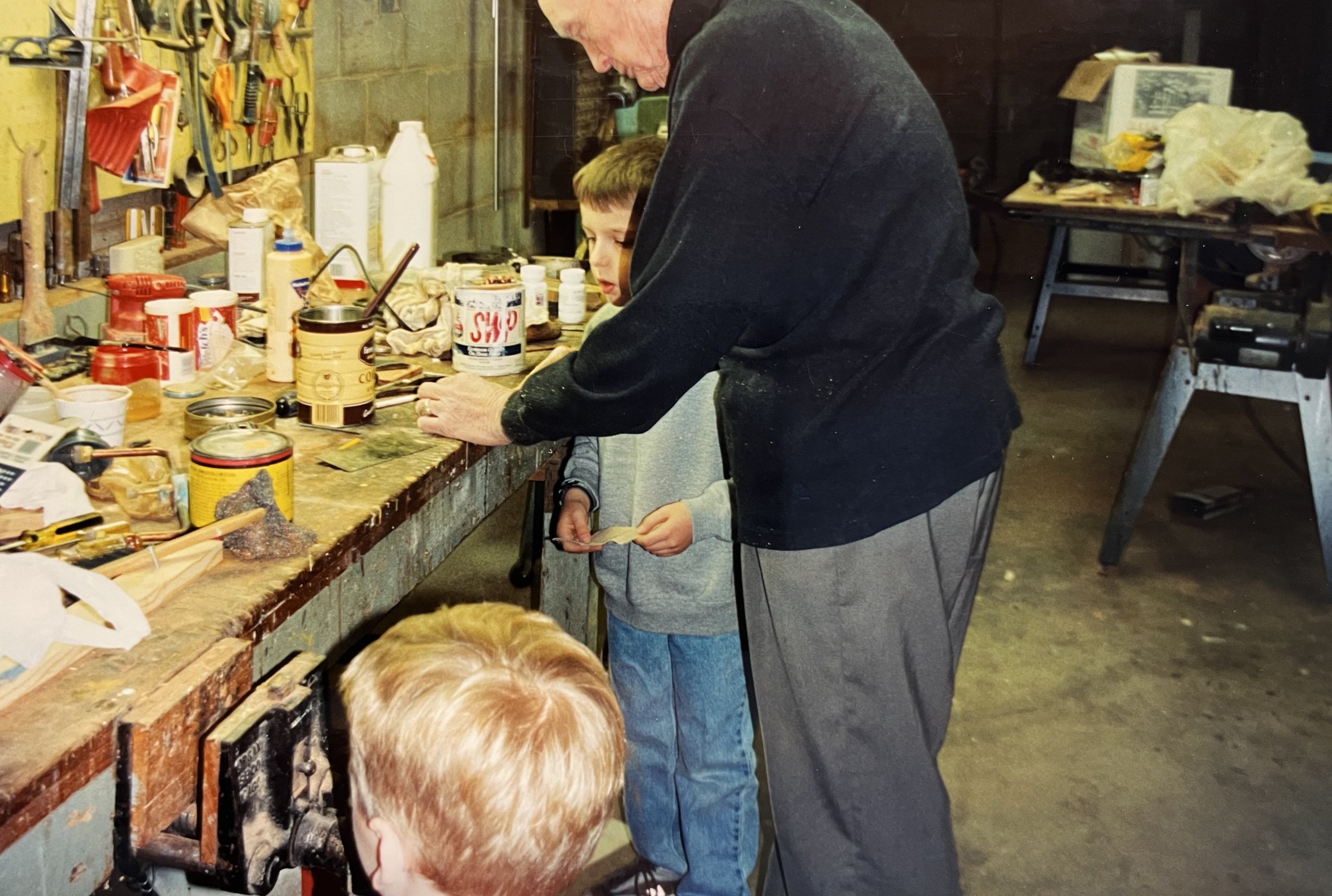
One of my earliest memories is of my grandpa Jim, my mom’s dad, helping me build a pinewood derby racer in his garage in Juniata, Nebraska. I vaguely remember him showing me how he used an old band saw and belt sander to shape the racer’s aerodynamic body, whittling down compartments under the nose to fit weights so that the car would accelerate more rapidly.
Grandpa Jim’s enthusiasm for wind drag and optimal weight distribution was lost on my preteen self and, even as an adult, I don’t quite share his fervor for engineering balsa. But how he kept his garage has stuck with me: filled with projects in different states of completion, littered with tools (you’d swear it was disorganized, but he knew where everything was), and always frosted with a fine coat of sawdust.
He wasn’t the only elder family member with a passion for tinkering. My dad’s dad, Lannie, had multiple garages, the largest of which was bigger than any apartment I’ve ever rented. It housed a full woodshop, his 4x4 ATV, the classic car he was working on at the time, and, notably, a full bathroom, complete with a shower. His wife, Sharon, forbade any of us from entering her “nice, clean house” without washing off whatever mess we had gotten ourselves into that day.
Growing up in garages has forever cemented my appreciation for them as dirty, non-precious spaces set aside for residents to transform into a stage for activities not accommodated elsewhere in the home. Grandma Sharon’s “nice, clean house” rule always felt like an acknowledgment of the garage’s consequential role in our lives as the space where we prepared ourselves for the rarefied domestic interior. For people like us, garages are the front door to a vital part of the house. For others, garages can be an entryway to thinking about how we might harness our living spaces to better suit our needs, and how our homes might better connect us to one another.
My grandpas used their garages as de facto workshops, but a workshop is just one thing a garage can be. In their 2017 publication Rebel Garages, Ann Lui and Craig Reschke of the architectural practice Future Firm documented a series of retrofitted garages from around their headquarters in Chicago that had come to do more than store cars—and instead host things like artists’ studios, a music venue, and an agricultural pickup spot—showing how these shape-shifting spaces offer places for community and culture. The authors go on to describe alleys, those urban cousins of garages that do everything from store trash to host block parties, as the connective tissue that stitches together experiments in DIY placemaking with a city’s built environment.
Unprogrammed space, like unprogrammed time, allows for creative freedom. For Alessandro Orsini and Nick Roseboro of the studio Architensions, that freedom is born when we shelve modern sensibilities around the separation of work and play. “The creation of spaces and programs for free time—such as the park and the stadium—speak about the artificial institution of division in the urban context,” they wrote in a 2022 essay called “Log-in Labor, Log-in Leisure.” The pair proposes reorganizing our homes and cities based on Dutch cultural theorist Johan Huizinga’s principles of play in his 1938 book Homo Ludens, which posits that play should be organized but free, and not done solely to create something physical and of value.
It’s not a bad idea. My parents wouldn’t like to hear that I grew up around power tools—but in my grandpa’s workshops, those tools were their medium for play. Did they ever produce things of “value” in their garages? Maybe, but that certainly wasn’t the point. Classic cars, refurbished table legs, and a semi-functional trebuchet came into existence in those entropic spaces. The end result was always second in importance to figuring out how to make it.
In garages, ephemerality often accompanies entropy. Flexible architecture invites people to mold their spaces to fit their lifestyles—which may not adhere to a floor plan, furniture layout, or traditional definitions of domestic space. Andrés Jacque’s architectural performance series “Ikea Disobedients” (2011–12) underscores this reality. Carried out on a set of a residential interior built with objects from Ikea—whose advertisements have historically depicted the home as sunny, apolitical spaces for primarily young, blond, healthy families who either have children or are about to—the project, first performed in Madrid, hosted live, public conversations and activities by local community members that were typically done in private. In showing how the normative behaviors associated with living spaces aren’t necessarily followed by everyone, the performances celebrate alternative models of domesticity and the areas that allow for it.
Our homes ought to allow for more subtle forms of self-expression, too. My dad’s garage isn’t augmented to the degree that my grandpas’ were, but there are still things about it that speak to me about who he is. Inside, band and concert posters cover nearly every inch of drywall, a blank slate for his own embellishing. They’re the first thing that greets me as I arrive home (and enter through the garage, of course), and they help me understand my dad’s relationship with a community of music junkies.
Among the posters is a set of old nylon fold-out camping chairs. While unassuming, these seats are crucial to many midwestern households. When thunderstorms come through in spring and early summer (provided that there aren’t any sirens, and that the beloved Nebraska weatherman Bill Randby isn’t on TV), the garage momentarily transforms into a storm-viewing deck for watching the rain and wind roll through. Once the storm passes, the garage goes back to being unprogrammed until it needs to be something else: a movie theater, a practice space, a workshop, or whatever we want it to be.